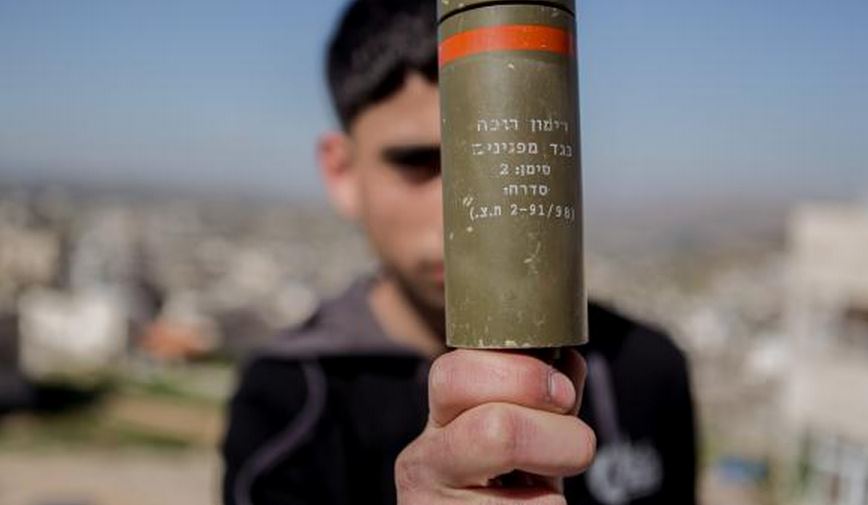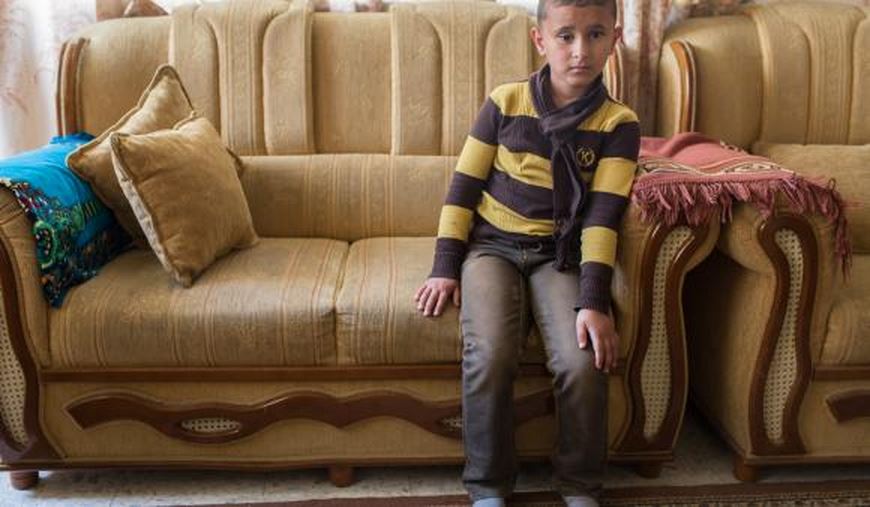




 |
 |
 |
 |
 |
VIP Forums Muzblog Chat Games Gallery. Ôîðóì, ìóçäíåâíèêè, ÷àò, èãðû, ãàëëåðåÿ. |
||||
|
||||||||
| Diaspora News and events in Armenian and other diasporas. |
 |
Pursuing Justice in a Culture of Impunity: Ivan Karakashian of ‘Defense for Children International Palestine’ |
LinkBack | Thread Tools | Display Modes |
|
|
#1 (permalink) |
|
Top VIP VIP Ultra Club
Join Date: Jan 1970
Posts: 12,055
Rep Power: 67
 |
Special for the Armenian Weekly
This past summer during the height of Israel’s “Operation Protective Edge” against the Gaza Strip, I noticed the name Ivan Karakashian, advocacy unit coordinator of Defense for Children International Palestine (DCI-P) cited in news reports. DCI-Palestine is an independent children’s rights organization dedicated to defending children living under Israeli military occupation. Karakashian was quoted in numerous press accounts about a Palestinian boy who was used as a human shield by Israeli soldiers on the ground in Gaza. I knew that with a name like Karakashian there was an Armenian connection, and I contacted Ivan and arranged to interview him twice, once via Skype from Jerusalem and once when he was in New York City in late 2014 as part of a speaking tour hosted by Tree of Life Educational Fund, a peace and social justice organization established by the First Congregational Church of Old Lyme, Conn.  A boy holds a canister of rubber-coated metal bullets. When fired, the charges inside disperse, hitting anyone nearby. (Photo: DCI Palestine) A boy holds a canister of rubber-coated metal bullets. When fired, the charges inside disperse, hitting anyone nearby. (Photo: DCI Palestine)Ivan Karakashian told me of his family’s peregrinations, starting with his grandfather’s arrival from Kutahya; their purchase of a house in Katamon in West Jerusalem in 1947; losing the house even before they were able to move into it in 1948; the two months they spent in the Armenian convent during the 1948 war; their sojourn in Amman, Jordan, before returning to live behind the Nablus Road shop in 1950; and their building the Karakashian family home in Shu’fat in 1954. The family was in Jerusalem during the 1967 war, and when it was over Israeli authorities came to the house and told them to go to a center to register for permanent residency status. The family lives in the same house to this day, and its members carry “blue identity cards” that denote Jerusalem residency. Ivan Karakashian worked for the Committee to Project Journalists (CPJ) from 2005-08 in New York City. “At CPJ, I was a researcher for the Middle East and North Africa program,” he told me.»“I honed many of my skills at CPJ, reporting in-depth on press freedom violations. Much of my time at CPJ involved remotely investigating the killing of journalists in Iraq and determining whether it was directly related to their work. It was difficult interviewing family members over the phone—often an hour or two after the death—to accurately report the circumstances, but I developed the sensitivity to deal with those experiencing loss and trauma.” “It was difficult interviewing family members over the phone—often an hour or two after the death—to accurately report the circumstances, but I developed the sensitivity to deal with those experiencing loss and trauma.”In February 2013, Ivan took the position as coordinator of the Advocacy Unit for DCI-Palestine. DCIP was founded in 1991 by Rifat Kassis as a legal aid association for children held in Israeli military detention. In 2001, the mandate was broadened and DCIP started monitoring all rights violations against Palestinian children in the Occupied Territories. In 2005, they also started monitoring infractions by Palestinian factions and armed groups as a way to fully protect Palestinian children’s rights. More than 8,500 children, the vast majority of them boys between the ages of 12-17, have been imprisoned in Israel’s military jails since 2000.  Othman, 15, has spent over 11 months under house arrest on suspicion of throwing stones. He was arrested when he was 14 years old. His father told DCI that the interrogators were physically violent, and threatened to rape his son. (Photo: DCI Palestine) Othman, 15, has spent over 11 months under house arrest on suspicion of throwing stones. He was arrested when he was 14 years old. His father told DCI that the interrogators were physically violent, and threatened to rape his son. (Photo: DCI Palestine)Karakashian explained that DCIP monitors and documents violations against children by “obtaining affidavits from multiple witnesses, evidentiary photographs, and supporting documents such as medical reports.” They then share this information with UN agencies, international legal bodies, and non-governmental organizations. DCIP statistics and narratives are used in reports by a range of groups and organizations, from Amnesty International to the U.S. State Department. As the coordinator of DCIP’s Advocacy Unit, Karakashian handles traditional advocacy, and he also works with the mainstream media, providing information about violations of children’s rights to journalists covering Israel’s military occupation and its almost bi-annual incursions into Gaza. He also utilizes alternative tools, such as social media and online advocacy, to try to build a grassroots, global movement to hold Israel to account for its violations of children’s rights. A recent example of DCIP’s efforts to pursue justice for Palestinian children is the story of the Beitunia boys. On May 15, 2014, two unarmed teenaged boys, Nadim Siyam Nawarah and Muhammad Mahmoud Salameh, were shot and killed with live ammunition by Israeli border police in separate incidents after Nakba (Catastrophe) Day protests near Ofer Prison. Video footage from security and media cameras showed that the killings were unprovoked. DCIP worked with Forensic Architecture, a London-based organization whose principal investigator is Eyal Weizman, an Israeli architect and professor at Goldsmith’s University, to identity Nadim Nawarah’s killer. Forensic Architecture’s video analysis showed convincingly that live ammunition was used, something Israeli authorities had consistently denied previously. Efforts by DCIP, Forensic Architecture, the Israeli human rights group B’Tselem, and the boys’ families resulted in the indictment of an Israeli border policeman. DCIP is continuing to use social media to help spread the boys’ stories and to pursue justice for the Nawarah and Salameh families. The #NoMoreForgottenLives campaign»employed a well-designed slideshow that gives the narrative of the boys’ killings and ends with an opportunity to join a Thunderclap, a social media tool that helps groups amplify their messages on Twitter, Facebook, and Tumblr.  6-year-old Mousab now wears a glass eye after he was hit directly in the right eye with a rubber-coated metal bullet. (Photo: DCI Palestine) 6-year-old Mousab now wears a glass eye after he was hit directly in the right eye with a rubber-coated metal bullet. (Photo: DCI Palestine)“Here in the West Bank, there’s no real difference between an Armenian and a Palestinian,” Ivan Karakashian said. “Just because I’m Armenian doesn’t mean that I’m treated differently from other Palestinians. I am a Palestinian of Armenian descent. We suffer the same harassment that Palestinians suffer, and inhale the same tear gas. I grew up witnessing human rights abuses and violence in the West Bank.” “Here in the West Bank, there’s no real difference between an Armenian and a Palestinian. Just because I’m Armenian doesn’t mean that I’m treated differently from other Palestinians. I am a Palestinian of Armenian descent. We suffer the same harassment that Palestinians suffer, and inhale the same tear gas. I grew up witnessing human rights abuses and violence in the West Bank.”On his way to work each day, Karakashian crosses the notorious Qalandiya checkpoint between East Jerusalem and his office in Ramallah. Because of the international fame of the Kardashian sisters, the Israeli soldiers at the checkpoint now recognize that the name on his I.D. card is Armenian and this has become a source of banter. He also said that the Karakashian House of Shu’fat, as his family home is known, is on Israeli military maps. In the event of a “two-state solution” partition of Israel and Palestine, their house would be the boundary and always remain a part of Israel. He also told of cat-and-mouse games played on three sides of the Karakashian home by Palestinian boys and Israeli soldiers. “The atmosphere in East Jerusalem is increasingly tense,” he said, mentioning this past summer’s graffiti scrawled on walls saying, “Death to Arabs” and the attempted kidnappings of Palestinians by extremist Israeli settlers. Karakashian sums up his passion for his work: “Confronting the feeling of powerlessness I experienced growing up in Jerusalem drives me now to be an agent for change. We’re trying to get justice, but how do you get justice? By holding people to account. How do you hold people to account in a culture of impunity?” The embodied answer to Ivan Karakashian’s final rhetorical question is his work with Defense for Children International Palestine. The post Pursuing Justice in a Culture of Impunity: Ivan Karakashian of ‘Defense for Children International Palestine’ appeared first on Armenian Weekly. Special for the Armenian Weekly This past summer during the height of Israel’s “Operation Protective Edge” against the Gaza Strip, I noticed the name Ivan Karakashian, advocacy unit coordinator of Defense for Children International Palestine (DCI-P) cited in news reports. DCI-Palestine is an independent children’s rights organization dedicated to defending children living under Israeli military occupation. Karakashian was quoted in numerous press accounts about a Palestinian boy who was used as a human shield by Israeli soldiers on the ground in Gaza. I knew that with a name like Karakashian there was an Armenian connection, and I contacted Ivan and arranged to interview him twice, once via Skype from Jerusalem and once when he was in New York City in late 2014 as part of a speaking tour hosted by Tree of Life Educational Fund, a peace and social justice organization established by the First Congregational Church of Old Lyme, Conn. A boy holds a canister of rubber-coated metal bullets. When fired, the charges inside disperse, hitting anyone nearby. (Photo: DCI Palestine) Ivan Karakashian was born in Jerusalem to an Armenian father and a Palestinian Christian mother. He grew up in the Shu’fat neighborhood of East Jerusalem, and his family [...] The post Pursuing Justice in a Culture of Impunity: Ivan Karakashian of ‘Defense for Children International Palestine’ appeared first on Armenian Weekly. Special for the Armenian Weekly This past summer during the height of Israel’s “Operation Protective Edge” against the Gaza Strip, I noticed the name Ivan Karakashian, advocacy unit coordinator of Defense for Children International Palestine (DCI-P) cited in news reports. DCI-Palestine is an independent children’s rights organization dedicated to defending children living under Israeli military occupation. Karakashian was quoted in numerous press accounts about a Palestinian boy who was used as a human shield by Israeli soldiers on the ground in Gaza. I knew that with a name like Karakashian there was an Armenian connection, and I contacted Ivan and arranged to interview him twice, once via Skype from Jerusalem and once when he was in New York City in late 2014 as part of a speaking tour hosted by Tree of Life Educational Fund, a peace and social justice organization established by the First Congregational Church of Old Lyme, Conn. A boy holds a canister of rubber-coated metal bullets. When fired, the charges inside disperse, hitting anyone nearby. (Photo: DCI Palestine) Ivan Karakashian was born in Jerusalem to an Armenian father and a Palestinian Christian mother. He grew up in the Shu’fat neighborhood of East Jerusalem, and his family [...] The post Pursuing Justice in a Culture of Impunity: Ivan Karakashian of ‘Defense for Children International Palestine’ appeared first on Armenian Weekly. [img][/img] More... |
|
|

|
 |
|
|
|